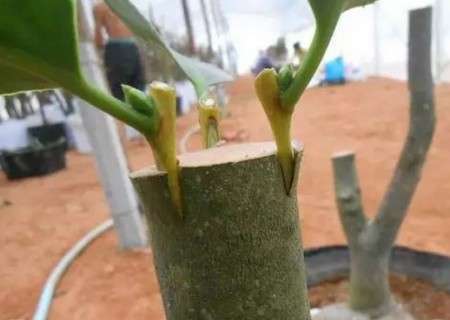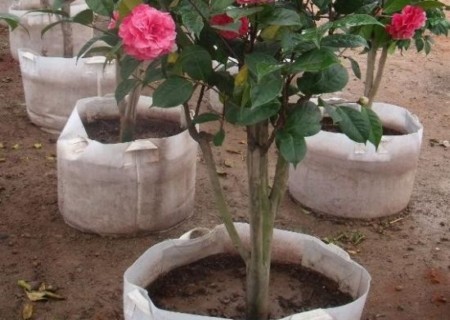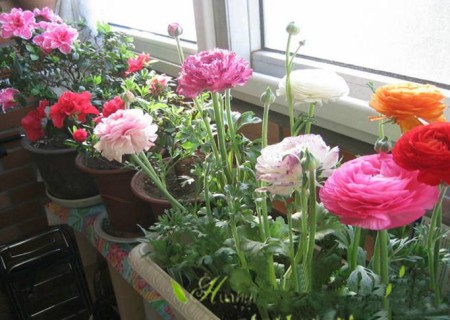Grafting method of potted Camellia
Put a few pots of camellias in the bedroom, can decorate the environment more elegant, in order to increase the interest of life. Potted camellias will have higher ornamental value if they are modeled and planted in a suitable bonsai. Camellia is a kind of tree species which is difficult to survive by grafting. In order to improve the survival rate of grafting, on the one hand, we should master the grafting skills, on the other hand, we must use some special grafting methods.
Grafting of camellia can improve its disease resistance and yield. In order to improve the survival rate of grafting, it must be in the peak period of water and nutrient absorption of rootstocks. Generally, it can be grafted from May to September. According to the experiment, June to July is the best, and the survival rate of grafting is as high as 90%. The following editor will introduce to you the methods of camellia grafting.

1. Skin tearing and embedding method
In the site to be grafted, parallel longitudinal cut two knives, deep to the xylem, about 3 cm long, the width depends on the thickness of the scion, generally 0.3 cm 0.5 cm, and then cut a knife, pick open the bark, so that the incision into an "H" shape. Take a scion with one leaf and one bud, about 2.5 cm long, cut the long strip flat mouth with wood on the opposite side of the petiole, and peel the line with a sharp knife on both sides of the flat mouth. Insert the scion into the incision of the rootstock and wrap it tightly, exposing only petioles and axillary buds. Then wrap the whole grafting site with a transparent film, leaving a space of 3 to 5 centimeters to form a moisturizing cover. After the scion survived and sprouted, remove the moisturizing cover and gradually cut off the branches of the rootstock to promote the growth of scion shoots.
2. Triangle embedding method
Cut the rootstock at the grafting site and cut it into a concave triangular groove with a sharp knife on one side of the cut of the rootstock, about 2.5 cm long, with a width depending on the thickness of the scion. Take a leaf and a bud scion, about 3 cm long, and cut it into a corresponding convex triangle from under the petiole. Insert the scion into the rootstock slot to make the two sides join closely and wrap the interface tightly. Then cover the scion and the grafting site with a plastic bag to form a moisturizing cover. After the scion bud germinates, loosen gradually until the moisturizing cover is removed.
3. Twig grafting
The so-called tender branch grafting method refers to the grafting of semi-lignified scion branches on the new branches of non-semi-lignified rootstocks, which is generally carried out by split grafting. After the grafting, cover the scion and the grafting site with two layers of plastic bags, and cover the Kraft paper bag to cover the bright light. Gradually remove paper and plastic bags after survival.
Because the rootstock and scion are young branches, the formation layer is thick, the healing is fast, and the survival rate is high, this kind of grafting method is the main method of camellia grafting or cultivating multiple varieties of camellia.
How to manage after grafting?
1. Cut off dry
The healing of the rootstock should be observed in time 20-30 days after grafting. The healed plant should cut off the trunk of the rootstock at 2 cm to 3 cm with a small saw and hold it down. Generally do not immediately truncate the trunk, because the scion does not have the ability to absorb nutrients, leaving part of the trunk to continue to absorb water and nutrients for scion growth, 70 days later, scion axillary buds begin to sprout, then all the trunk can be cut off.
2. Untie
When the axillary buds of the scion grow out, the original sealed film can be untied. The tight bandage will be cut off in about 20 days to make it grow and develop normally.
3. Remove the sprouts
There are many sprouting branches on the high-rootstock grafted rootstock and must be removed in time, otherwise it will affect the growth of the scion. Sprouting should be removed until scion growth is dominant.
4. Plastic surgery
After the grafting survived, it should be properly reshaped, according to the camellia tree shape and branch position needs, with rope binding directional shaping.
The principle of graft survival:
Cambium is a thin layer of meristem cells between phloem and xylem. During the growth period of suitable temperature, cambium can divide continuously and form phloem outward and xylem inward. Cambium plays an important role in the survival of grafting. No matter what grafting method is adopted, the cambium of rootstock and scion must be in contact with each other. the larger and closer the contact surface is, the more calli are formed on both sides, and the higher the survival rate of grafting is.
But sometimes, in the grafting practice, even if the cutting technology is relatively poor, the gap between the rootstock and the scion is relatively large, but as long as it can ensure the formation of a large number of calli and fill the gap, the grafting can survive. Therefore, the key to the survival of grafting is whether the rootstock and scion can grow enough callus.
Time: 2019-06-10 Click:
- Prev

Illustration of grafting method of potted Camellia
Camellia is a kind of tree species which is difficult to survive by grafting. In order to improve the survival rate of grafting, on the one hand, we should master the grafting skills, on the other hand, we must use some special grafting methods. Select the scion according to the resources of the variety, and then make a reasonable collocation according to the operator's personal preference.
- Next

When to sow Buttercup-the sowing method of potted Buttercup
Buttercup is also called celery flower. Any flower friend likes to order vegetables before the flowers bloom, but this guy doesn't have to pretend to be like a vegetable. Anyway, don't worry about the buttercup raised in the terrace before it blossoms. Mother-in-law kept saying, there is nothing to grow such a big pot of celery. I almost didn't get cashew nuts! It is a flower in cold season.
Related
- Fuxing push coffee new agricultural production and marketing class: lack of small-scale processing plants
- Jujube rice field leisure farm deep ploughing Yilan for five years to create a space for organic food and play
- Nongyu Farm-A trial of organic papaya for brave women with advanced technology
- Four points for attention in the prevention and control of diseases and insect pests of edible fungi
- How to add nutrient solution to Edible Fungi
- Is there any good way to control edible fungus mites?
- Open Inoculation Technology of Edible Fungi
- Is there any clever way to use fertilizer for edible fungus in winter?
- What agents are used to kill the pathogens of edible fungi in the mushroom shed?
- Rapid drying of Edible Fungi

